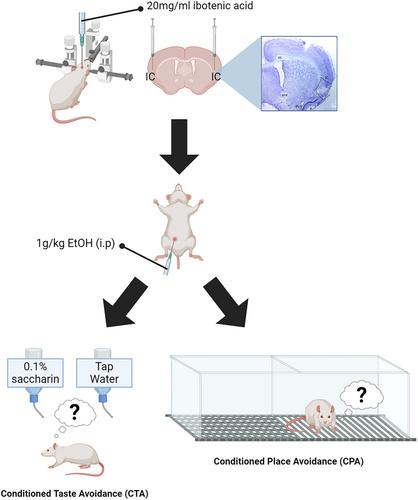Bilateral insular cortical lesions reduce sensitivity to the adverse consequences of acute ethanol intoxication in Pavlovian conditioning procedures
Abstract
Background
Sensitivity to the adverse post-ingestive effects of ethanol likely serves as a deterrent to initiate alcohol consumption early in drinking and later may contribute to efforts to remain abstinent. Administering ethanol to naïve rats prior to Pavlovian conditioning procedures elicits robust ethanol-conditioned taste and place avoidance (CTA; CPA) mediated by its subjective interoceptive properties. The insular cortex (IC) has been implicated as a region involved in mediating sensitivity to the interoceptive properties of ethanol. Here, we examined whether bilateral lesions of the IC affect the acquisition and expression of taste and place avoidance in ethanol-induced CTA and CPA paradigms.
Methods
Adult male and female Wistar rats received bilateral excitotoxic lesions (ibotenic acid; 20 mg/mL; 0.3 μL) of the IC prior to conditioning procedures. Subsequently, rats were conditioned to associate a novel taste stimulus (0.1% saccharin) and context with the effects of ethanol (1.0 g/kg) in a combined CTA/CPP procedure. Conditioning occurred over 8 alternating CS+/CS− days, followed by tests for expression of taste and place preferences. Data from IC-lesioned rats were compared with neurologically intact rats.
Results
Our findings revealed that neurologically intact rats showed a significantly stronger ethanol-induced CTA than IC-lesioned rats. There were no significant differences in total fluid intake when rats consumed water (CS−). As with CTA effects, intact rats showed a strong CPA, marked by a greater reduction in time spent on the drug-paired context, while IC-lesioned rats failed to display CPA to ethanol.
Conclusion
These results indicate that proper IC functioning is necessary for responding to the adverse interoceptive properties of ethanol regardless of which Pavlovian paradigm is used to assess interoceptive responsivity to ethanol. Blunted IC functioning from chronic ethanol use may reduce interoceptive signaling specifically of ethanol's adverse effects thus contributing to increased alcohol use.



 求助内容:
求助内容: 应助结果提醒方式:
应助结果提醒方式:


